2001year became a key in the history of Pavlodar state university, connected with cardinal change. At that time young energetic leader came to manage our university, whose initiative activity has no equal at present. E.Aryn paid special attention to the development of scientific base, following a principle - formation through science. Supporting all scientific directions without exception, he made a lot for development of historical science, as a basis of formation consciousness and culture, attracting for this big amount of specialists on different directions. One of them is archeology, for its development in this year on the basis of Pavlodar archeological expedition under PSU was created united archeological scientific-research center named after Alkey Hakanovich Margulan. Worked out regional program “Ethnocultural researches of Pavlodar Priirtyshie” included an archeological block, covered all main stages of ancient history of area from the antique Stone Age till late medieval ages.
With a view of this by staff of the Center was conducted a huge work on chronological coverage, directed on study of new archeological monuments and earlier collected materials. Results of these studies became writings of number of articles for encyclopedia “Pavlodar Priirtyshie” and scientific editions, release of photo album of cliff drawings, Kazakh-Russian archeological dictionary, and school manual; also there was shot a film of educational- documentary film about study of different monuments in the field of archeology. In January of 2003 was opened a scholastic archeological museum, which is a pride of university. At the heart of this exposure were lay down materials of Pavlodar archeological expedition, collected nearly during 15 years since 1988.
During this time was collected a unique archeological material. Only collection of multilayer stop of Shiderty-3 is more than 50 thousand units of issue. Due to this expedition was fixed and explored a huge amount of monuments, containing information on history of our land since ancient times, connected with an appearance of the first people on its territory and till ethnographic up-to-date. The presented exposure is not only the main index of the richest culture of ancient Priirtyshie and achievements of Pavlodar archeologists, but plays the great educational role, about what we wanted to display in this article.
The main idea of creation this exposures is a demonstration in unfolded type by the example of the best archeological samples of consequence of material and spiritual development of the ancient and medieval inhabitants of Priirtyshie. In exposure was presented a scheme of evolution of genus “homo” with samples of ancient Paleolithic tools from Pavlodar Priirtyshie and common types of the most important Paleolithic stops and other monument of the Stone Age. There are sections: lower, middle and upper Paleolithic, Mesolithic, Neolithic, and the Bronze Age (with sections early, developed, late bronze), sections of the early Iron Age and Hun-Sarmat time, cliff drawings, burial mounds and stone sculptures of the Medieval Ages. Sections of the early, developed and late Medieval and ethnoarcheology, reconstructions of Adronov culture burials and Korgantass type of Hun-Sarmat epoch, cenotaph (symbolic burial without the dead) of Commack time. There were presented beautiful collections of funeral stock, samples of ceramics, bronze, golden and stone goods, weapons, belt and bridle sets, leather and cloth goods and etc.
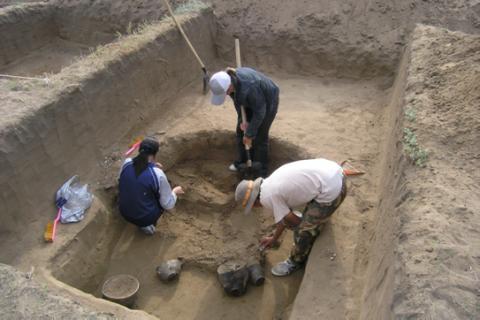
So, exposures beginning from Paleolithic –the ancient Stone Age, which is presented on the territory of Pavlodar Priirtyshie, connected with the period of early Anthropogenesis and settlement of ancient Hominids over Eurasia more than 1, 5 ml. years ago. It is a location of pebble tool with animals’ bones of Lebyazhie fauna complex, existed in the late Pliocene about 2 ml. years ago in Oldavay epoch. The later monuments with pebble tools were found near Zhambyl village in Lebyazhinsk region and Maraldy Lake, where they also proceed from ancient secessions with animals’ bones. The inhabitants of Irtysh stops used river pebbles for producing different tools.
In the left bank of the oblast ancient stops of the primitive people were adjusted to raw materials sources, where they used to make workshops on producing stone labour tools. The most studied monuments are located near Kudaykol Lake, where were collected splendid samples of Paleolithic tools, which reflect a level of stone production development of hunters on big mammals: elephants, mammoths, wolly rhinoceros and the other animals, inhabited in Priirtyshie in Ashelsk (700-100 thousand years ago) and Mustier (100-35 thousand years ago) epochs. This time is connected with an existence of ancient people, modern people and pithecanthropus and Neanderthals.
Late Paleolithic materials also were got with these monuments and stops Ekibastuz-15, cultural layer which is adjusted to geological secessions that allows defining its age within 16-17 thousand years ago i.e. the end of Ice Age. Stops of Paleolithic epoch with habitation remains are not found, but unfortunately, there are no Paleoanthropological discoveries more ancient than 5 thousand years.
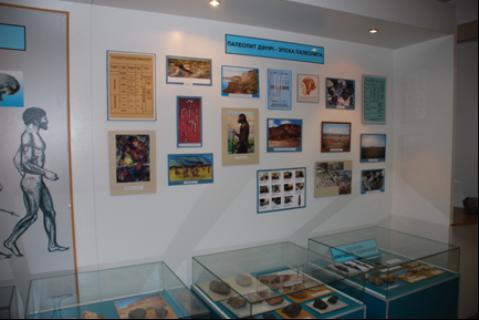
Paleolithic material is presented with instruments of stops-workshops Ekibastuz -18,-20 and locations of pebble tools of Priirtyshie stops Lebyazhie, Karaterek and Zhanaaul. They are: choppers, chopping, pulling instruments, nucleuses, manual chops. Materials are accompanied with illustrations on reconstruction technology of stone tools processing which allows graphically demonstrating a method of their production and possibility to understand vital activity of ancient people and draw near a visitor to the given historical period.
With a view of deeper understanding of the Stone Age history of Pavlodar Priirtyshie in context of the worldwide history were conducted parallels with other Paleolithic monuments of the West and East Europe. The presented reconstructions of Paleolithic habitations from mammoths’ bones, found near Mezherechi village on Ukraine and illustrations of samples of Paleolithic art - a sculpture from mammoth’s tusk and cave painting.
In the section, transferring from Paleolithic to Neolithic – Mesolithic epoch, are presented illustrations on technology of stone processing, which become complicated and improved at that time. Development of technical methods on stone processing at that time on territory of the North-East Kazakhstan graphically presents a collection of tools made from knife-edge plates, proceeding from Mesolithic layers of multilayer stops of the Stone Age Shiderty-3.
Exposure of Neolithic reflects the processes, connected with “Neolithic revolution” - a period of rise of agricultural forms and mastering new materials. These processes reflect fragments of the first primitive and perfect ceramics, complicated plate tools, together with an appearance of microliths - rough stone axes, hoes, scrapes and other products, found on stop Shiderty-3, Scherbakty-1 and Michurino-2 and others.
Neolithic epoch, connected with formation of producing facilities in region in the form of cattle breeding, founded on breeding cattle and horses, was presented in exposures with materials of the upper cultural layer of stop Shiderty-3. It contains a lot of interesting and unique subjects: of itself ensemble interesting and unique subject: ferrules of javelin and arrows, drills and tesla, plate knives, grindstones, iron, mounting of bone inlay knife and inlays with double-sided processing, ceramics. The samples of Neolithic technology of the splitting and further stone exploitation are nuclei, presented in exposures getting products from it: clips, scrapes, knives and tools with double processing – bifacial, served as knives, scrapes, shaves and etc.
It is necessary to note that reconstruction of Neolithic man’s figure was made by well-known Russian anthropologist L.T.Yablonskiy basing upon materials of burials of Shiderty-3. In the exposure was presented a necklace made from teeth of saiga and river beaver, found in this burial.
The Bronze Age begins with the materials of pit type burials, found in Grigorevka village and Krotov-Elunin monuments from burial mound Shiderty-10; settlements Shauke-3 and Michurino reflect an epoch of early bronze period, practically not studied in Kazakhstan, connected with development of tribes’ culture, preceding an appearance of Andronov monuments. It is a ceramics with moulded platens and solid ornaments on vessels, bone, stone and bronze subjects. There is also a bronze plug axe-Celt and illustrations of the other tools of this amazing trans-cultural phenomenon of the Bronze epoch, keeping in different museums: ferrules of javelin, Celts, daggers.
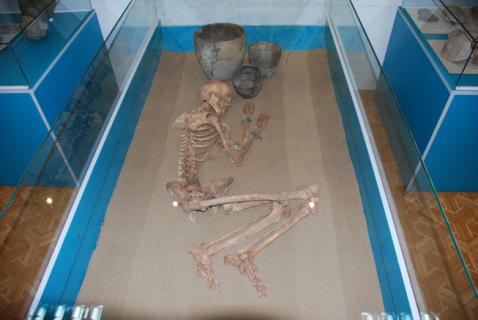
The developed Bronze epoch, connected with culture of Andronov tribes is presented not only by a big number of ceramic containers, which forms a base of this exposure, but also bronze knives and daggers, bracelets, rings, temporal rings, lavalieres from burials of Michurino-1 and Kara-Tumsyk, reconstruction of its bonding and photo materials, reflecting process of studying these monuments. In special showcase is a reconstruction of funeral tribe’s rite of the developed bronze epoch, which graphically demonstrates a specific pose of the buried, in writhed type with stock.
Exposure of the Bronze epoch, placed in the big shop windows, unites a big photo pennon with pethroglyphs from Ak-Bidaiyk, where in 1990 by expedition was discovered an ancient sanctuary with cliff drawings.
The Bronze Age exposure finishes with the materials of Begazy-Dandybay culture, explored on mortuary Sholpan-5 and range of settlements of the late bronze epoch. It is products of potter metallurgical production, presented in the form of moulded and machine ceramics, bronze and bone instruments. Ritual stone eggs are of great importance, met on settlements and separate treasures of this period. Such ritual treasure was found by pupils of Akshi school in Bayanaul region, where were more than 50 such units.
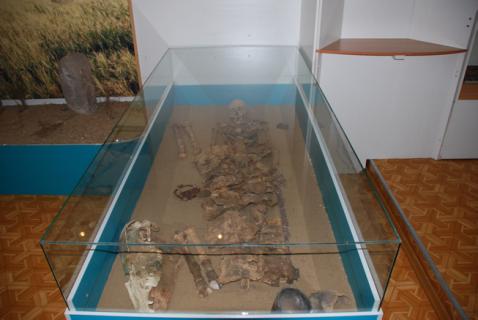
An exposure, devoted to early Iron Age on the territory of our land, is presented by separate subjects and richly illustrated with photo materials of Tasmola and Sargat cultures. They are ritual burial mounds with “moustache” and stone pictures with skiff deer, found on Toraigyr Lake; bronze knives and stone sacrifices and reconstructed ceramic coppers for boiling meat. In exposures there are iron ferrules of arrows, ceramic containers, furnishings and unique samples of cold steels of Hun-Sarmat epoch, presented by casual discovery of perfectly Sarmat sword - akinak. Due to materials of Korgantass culture was made a reconstruction of burying warrior of Hun-Sarmat epoch in the composite stone box in mortuary Shiderty-17.
Medieval epoch exposure begins with a presentation of panorama of steppe landscape with burial mounds and stone sculptures, which are symbols of Turk epoch and reconstruction of cenotaph - burials of things and weapons of Commack warrior, the deceased on foreign land. This is a unique sample of the ritual practice of the medieval nomads of Priirtyshie was discovered by expedition, together with other medieval burials near Grigorevka village. There were found rich bridle and belt sets, furnishings, testaceous armors, iron swords, ceramic containers and arrows with iron ferrule, remains of bow with bone brackets, stirrups, wooden, bone, leather goods, fragments from silk and other fabrics.
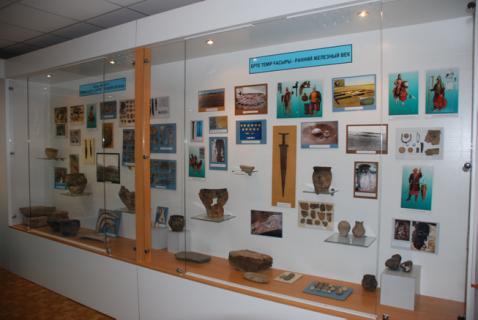
Subjects came from the Medieval epoch were presented by fragments of machine and sculpture ceramics, metallic goods. There were presented photos of cliff drawings of the medieval nomads, found in Bayanaul mountain outskirts. Silver mirror and furnishings are devoted to Mongolian period from Shiderty-3 stop.
The Collection of the late medieval ages was presented in exposures as debris of bricks and ceramic glazed tiles from memorial monuments, cult architecture of XIV-XVI, explored by Irtysh expedition, which was organized by the university with Institute of archeology named after A.H.Margulan NAN of RK, in May, Bayanaul, Ekibastuz and Aktogay regions. One of these monuments, so called “Kalbasunskaya tower” is studied by expedition for several years in May region. In 2004 there were explored remains of one of the similar buildings with triple stone crypts, built from the burnt square bricks, where were buried the representatives of Zhuchi aristocracy. Similar architectural monuments, connected with the medieval culture of Altyn Orda epoch firstly were studied on the territory of the North-East Kazakhstan. New direction in archeology was opened due to these studies.
There is section, dedicated to ethnoarcheology - one of the youngest and perspective directions in historical science. There are materials about Barabin Tatars culture from settlement Vtory-3 near Zhelezinka village in the north part of the area, goods from Kazakh wintering, Russian settlements and mortuaries of XVIII-XIX, ceramic containers, underclothes crosses, coins and sinkers from Lebyazhinsk outpost and Zhelezinsk fortress, photographs of mazar, monuments with anthropomorphous outlines, funeral and graveside inscriptions.
This exposure is finished with the last shop window, devoted to life and creative activity of prominent Kazakh scientist, founder of archeological science in Kazakhstan, academician A.H.Margulan, which was opened due to his 100 anniversary. There were presented photographs, manuscript, drawings, personal belongings, notebooks, copy books, archeological discoveries, and lifetime and jubilee editions of the scientist.
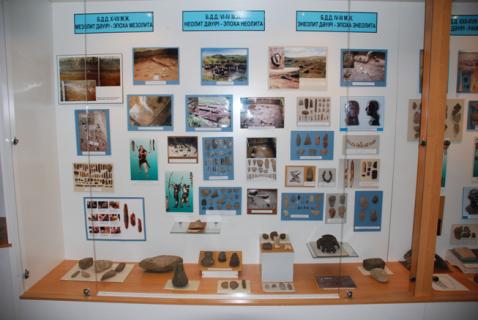
So, exposure of the museum is built on rich actual material, got in the result of long-term archeological studies, graphically reflecting a consequent development of material culture on the territory Pavlodar Priirtyshie since ancient times till historical modern period. There were presented in local scale the all stages of ancient history, including development history of archeological science. It gives a real belief about material culture of ancient nations of Kazakhstan and it is a good manual for studying history. So it is necessary to say that scholastic museum in higher educational establishments have a significant importance as for educational process as a whole, so for development of science and formation of adequate idea about peculiarities of historical processes not only for the future historians, but also for students, studying other professions.
Exposure of the museum is constantly complemented with new exhibits got in the course of field studies of archeological centre and educational practical of students. New discoveries of the last season is exhibited in the form of accounting material in separate small shop windows, then the best part moves to the constant exposure. At present there are about thousand units of issue, collected by Pavlodar archeological expedition before 2001 and expedition of PSU during the 4 field seasons. As a whole, funds of Archeological research Centre is about several tens of units. Not every scientific centre and museum has such archeological funds, that is why our Archeological Centre has perspectives for scientific activity.
Head of the united archeological scientific-research center of PSU named after S.Toraigyrov V.K.Mertz






